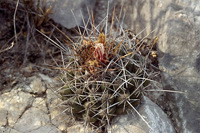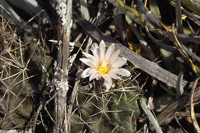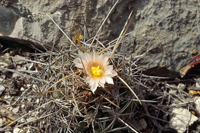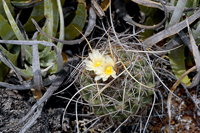Basionym: Echinocactus tulensis Poselger, Allg. Gartenz. 21: 125 (1853).
Neotype: At KM14 on highway 101 between Tula and the junction at hy. 80 in Tamaulipas, 30 July 1979, Edward F. Anderson 3202 (US 3047835), E.F. Anderson, Bradleya 5: 64 (1987).
Synonyms: Thelocactus tulensis ssp. huizachensis Halda & Sladkovsky, Acta Mus. Richnov. sect. Nat. 7: 39 (2000). Thelocactus tulensis ssp. kupcakii Halda & Sladkovsky, Acta Mus. Richnov. sect. Nat. 7: 40 (2000). Thelocactus vaskoanus Halda & al., Acta Mus. Richnov. sect. Nat. 7: 75 (2000). Thelocactus tulensis ssp. vaskoanus Halda & al., Acta Mus. Richnov. sect. Nat. 9: 41 (2002).
Description
Stem single or clustering, globose to elongate, 10-25 cm tall, 6-8 cm wide. Ribs 8-13, distinct. Tubercles rounded. Areoles without glands. Central spines 1-4, 30-80 mm long, straw coloured to whitish, straight to twisted, flattened. Radial spines 5-12, 7-20 mm long, straight, acicular. Flowers 30-60 mm wide, white or light pink. Seeds 1.7 x 1.4 mm, testa cells tabular with a verrucose surface sculpture.
Distribution
Mexico, San Luis Potosí and Tamaulipas, occurring in matorral xerofilo on limestone hills, at elevations of about 1200 to 1900 metres above sea level. Its range lies within the Meseta Central subregion of the Chihuahuan Desert ecoregion.
Risk assessment
Thelocactus tulensis is placed in the category A (threatened) of the Norma Oficial Mexicana NOM-059-SEMARNAT-2010.
Comments
Tula is a small town in the state of Tamaulipas, and this species takes its name from it. Thelocactus tulensis may be found in the wild from Tula to Las Tablas and Huizache in San Luis Potosí.
Huizachensis refers to a form found near Huizache, intermediate between tulensis and bicolor.
Kupcaki is the name given to a form with longer spines occurring near Las Tablas, San Luis Potosí.
Vaskoanus refers to what is probably the most southern form found near Rio Verde, San Luis Potosí, with clavate stems and smaller flowers.
Thelocactus tulensis (Poselger) Britton & Rose, Cact. 4: 11 (1923).
 The neotype of Echinocactus tulensis Poselger.
The neotype of Echinocactus tulensis Poselger.
At KM14 on highway 101 between Tula and the junction at hy. 80 in Tamaulipas, 30 July 1979, Edward F. Anderson 3202 (US 3047835)
Image courtesy CONABIO.
enlarge
 Thelocactus tulensis
Thelocactus tulensis
Rancho Nuevo, San Luis Potosí
Photo: A. Mosco
enlarge
 Thelocactus tulensis
Thelocactus tulensis
Rancho Nuevo, San Luis Potosí
Photo: A. Mosco
enlarge
 Thelocactus tulensis
Thelocactus tulensis
El Huizache, San Luis Potosí
Photo: A. Mosco
enlarge
 Thelocactus tulensis
Thelocactus tulensis
La Morita, San Luis Potosí
Photo: A. Mosco
enlarge